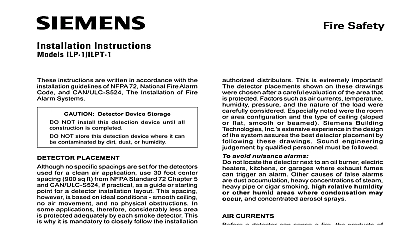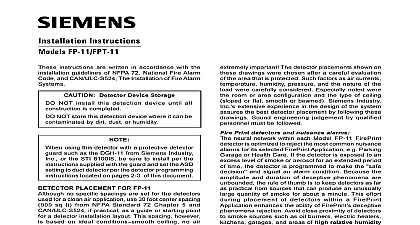Siemens ILI-1, ILI-1H, ILI-1A, and ILI-1AH Smoke and Fire Detector, Installation Instructions

File Preview
Click below to download for free
Click below to download for free
File Data
| Name | siemens-ili-1-ili-1h-ili-1a-and-ili-1ah-smoke-and-fire-detector-installation-instructions-2473598106.pdf |
|---|---|
| Type | |
| Size | 737.91 KB |
| Downloads |
Text Preview
Installation Instructions and Fire Detector Models ILI 1H ILI 1A and ILI 1AH instructions are written in accordance with the guidelines of NFPA No 72 National Fire Code and CAN ULC S524 The Installation of Alarm Systems Storage NOT install the detector until all construction completed NOT store this detection device where it can contaminated by dirt dust or humidity PLACEMENT no specific spacings are set for the detectors for the 0 to 300 ft min clean air velocity applica use 30 foot center spacing 900 sq ft from NFPA National Fire Alarm Code Chapter 5 if practical a guide or starting point for a detector installation This spacing however is based on ideal ceiling no air movement and no obstructions In some applications therefore less area is protected adequately by each detector This is why it is mandatory to closely the installation drawings In all installations in special circumstances such as in computer underfloors where the velocity may be up to 1200 place the detector on the ceiling a minimum of inches from a side wall or on a wall 6 inches from ceiling you have questions regarding detector placement the drawings provided or approved by Siemens Technologies Inc or by its authorized This is extremely important The detector shown on these drawings were chosen a careful evaluation of the area that is protected such as air currents temperature humidity and the nature of the fire load were carefully Especially noted were the room or area and the type of ceiling sloped or flat or beamed Siemens Building Technologies extensive experience in the design of the system the best detector placement by following these Sound engineering judgment by qualified must be followed Building Technologies Inc Fernwood Road Park New Jersey 07932 315 095387 5 Safety AVOID NUISANCE ALARMS WITH THESE NOT LOCATE the detectors next to an oil burner or garage where exhaust fumes can trigger alarm Other causes of nuisance alarms are dust heavy concentrations of steam heavy or cigar smoke aerosol sprays high air velocity in an area of prolonged high relative humidity where occurs Except in the case of the ILI 1A and ILI 1AH the detector can be used for high air applications of up to 1200 feet per CURRENTS a detector can sense a fire the products of or smoke must travel from the fire to the Since their travel is influenced by air currents the movement of air in the design of the While combustion products tend to rise drafts hallways air diffusers fans etc may help or the travel of combustion products to the When positioning a detector at a particular consider the position of windows and doors open and closed and air movement Never install detector in the air stream of a room air supply diffuser is better to position a detector closer to an air return distance that products of combustion or smoke travel a fire to the detector is not usually the shortest linear Combustion products or smoke usually rise to ceiling then spread out With an average ceiling 8 to 10 feet this is not an abnormal factor with high ceilings such as in churches ware auditoriums etc consider the height CEILING CONSTRUCTION FACTORS obstructions can change the natural movement air and combustion products Depending on the of smoke travel joists and beams can slow movement of heated air and smoke while pockets them can contain a reduced level of obstructions created by girders joists air conditioning ducts or architectural design consideration when determining area protection Building Technologies Ltd Kenview Boulevard Ontario L6T 5E4 CN ILI 1H ILI 1A and ILI 1AH Installation and Wiring Diagram 1 to the Initiating Devices chapter of NFPA 72 for Location and Spacing requirements specific types of construction e g beam level sloped and peaked ceilings AND HUMIDITY temperature range for the ILI 1 Series is 32 to 100 38 The four models can each be in environments where the humidity does not ex 93 non condensing changes of atmospheric pressure have a effect on detector sensitivity However the air pressure at higher altitudes does have some on the sensitivity of ionization type detectors to the following table area Open area area Computer facilities Air duct spots area Computer facilities Air duct spots NOTE HIGH STOCKPILING general detector placement for high stockpiling re closer spacing depending on the nature of the its stored height and the height of the building technologies recommend additional detector at tiered lower levels Detector placement this type hazard requires a judgment factor that only be provided by experienced qualified WIRING Building Technologies Inc detectors should interconnected as shown in Figure 1 and wired to control panel by following the Wiring Diagram on the inside face of the control panel or in Control Panel Manual provided Note any on the number of detectors permitted on circuit MOUNTING detector has a separate base which attaches to a 4 inch square 4 11 16 inch square 4 inch or single gang outlet electrical box The depth the box is determined by the NEC for the number and of the conductors used A finishing trim ring Model is available for bases using a 4 inch square box MOUNT Route all wires outward from outlet box Place the detector so that the ALARM LED is visible by positioning the LED mark in the in the necessary direction See Figure 2 Mount base to outlet box and wires through the hole the center of the base connections directly the base terminals Refer Figure 1 for details When mounting base and routing through the cutouts in air shield make sure shield is sealed against leaks Open the cutouts as much as required Remove factory installed in base between 1a and 1b 2 Installation To ensure proper installation of the detector head the base check that the wires are properly at installation all wires flat against the base up all slack in the outlet box Route wires away from connector terminals OF DETECTOR HEAD Align notch in detector cover to raised surface on ring of base See Figure 3 Push detector head base and rotate to make connections detector auto stops and into place To push head up into base while rotating detector head Continue to rotate counter until stop is reached Then pull to disengage from base Mounting 3 detector on a loop must be programmed to to a unique system address To program the detector address use the SIEMENS FPI 32 Programmer Tester Refer to the OPERATIONS MANUAL P N 315 090077 Record the loop and device number system ad for the detector on the detector label ADJUSTMENT Systems sensitivity of each detector can be adjusted from System XL3 Control Panel Refer to the SYSTEM OPERATION INSTALLATION AND MAINTE MANUAL P N 315 083206 Control Panels sensitivity of each detector can be adjusted from MXL MXL IQ Control Panel Refer to the MXL INSTALLATION AND MAINTENANCE P N 315 092036 or the MXL IQ OPERATION AND MAINTENANCE MANUAL P N as applicable Modules in IXL Systems sensitivities of detectors on an ICON 1 module are from the IXL Control Panel Refer to ICON 1 P N 315 093087 as well as the IXL Manual P N 315 092394 for additional AND SENSITIVITY MEASUREMENTS Systems qualified service personnel should test Refer to SYSTEM XL3 OPERATION INSTALLATION MAINTENANCE MANUAL P N 315 083206 as frequently as required by the Installation and Guidelines of NFPA 72 Obtain detector sensiti


